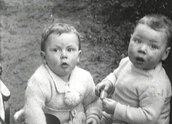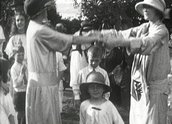



Higgins, Bryce: Family and Holiday Scenes: 1909-1924 (c.1909)
Synopsis
This home movie footage, filmed mostly by Ernest Higgins, includes scenes of a family picnic at Mt Wellington, Christmas celebrations, children’s birthday parties, picnics, holidays and other family gatherings between 1909 and 1924.
Curator’s notes
This beautifully filmed home movie contains some of the earliest examples of home movie footage held by the National Film and Sound Archive. What makes this footage even more exceptional is that it was filmed on 35mm nitrate film by a member of one of Australia’s pioneering film families. The quality, subject and provenance of this home movie make it captivating viewing.
The young Higgins worked as a bioscope operator in Hobart and bought a 35mm movie camera with which he filmed this home movie. Home movie recordings from the early part of last century are quite sparse, home movie making becoming more common with the invention of 16mm film in the early 1920s. While 16mm was a less expensive alternative to 35mm, the camera was still priced beyond what most people could afford, and amateur filmmaking during the 1920s and 1930s was a hobby for a privileged few.
Ernest’s talent as a cameraman can be seen in his careful framing and choice of what to focus on. Most of these home movie segments are static shots, although there are also examples of subtle camera movements which follow the flow of the action (as seen in the children’s party of clip four). The compilation contains a number of intertitles which provide names, dates and places which identify the footage. Each segment presents as a self-contained vignette of the Higgins’ family life.
In 1908 Ernest Higgins filmed a boxing match between Jack Johnson and World Heavyweight Champion Tommy Burns at Rushcutters Bay in Sydney. In 1909 he was working with Cozens Spencer on newsreels and travelogues, and in 1910 he made the documentary Melbourne: Queen City of the South, the earliest surviving documentary of Melbourne, for Cozens Spencer.
Ernest’s younger brothers also became cinematographers and went on to film some of Australia’s best known early feature films. Tasman became known for his outdoor photography and worked on parts of In the Wake of the Bounty (1932) and the cavalry scenes for Forty Thousand Horsemen (1940). Arthur, the most prolific, worked on The Sentimental Bloke (1919), On Our Selection (1920) and The Woman Suffers (1918). A ten-year-old Arthur can be seen briefly in clip one at the Higgins family picnic at Mount Wellington.
The NFSA has recorded two oral histories with Ernest’s son, Bryce Higgins, in which he recounts his family’s involvement in the film industry.
- Overview
- Curator’s notes
- Video 4 clips

- Find a copy
- Make a comment
- Map
- Add your review



